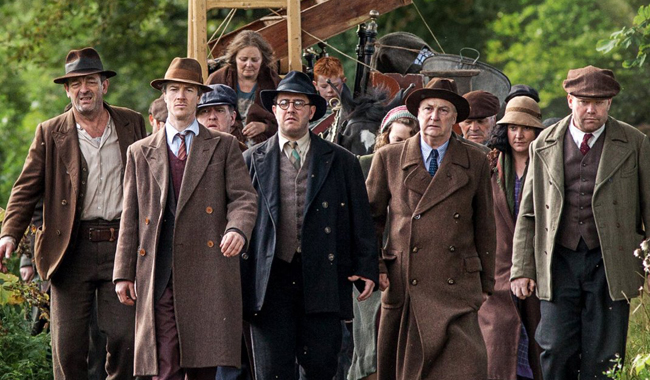
Jimmy’s Hall Review
 The latest film from auteur Ken Loach is Jimmy’s Hall. This film is to be, as Loach has insinuated his last film. For that it loses none of its power. Jimmy’s Hall is very much made as a companion piece to his superb, violent and shocking The Wind That Shakes the Barley (2006). Granted, not a direct sequel but it is a good follow-up story. The Wind That Shakes the Barley was a shocking indictment on British rule and the lengths the masters would go to stop nationalist revolt and the success of the IRA following the Easter Uprising in 1916. The Wind That Shakes the Barley is set in the early 1920s, in the years leading up to Irish independence in 1922 and how the rebellion tore a family apart. The lead character in Jimmy’s Hall is the real life figure of Jimmy Gralton (played by Barry Ward) ‘inspired’ by Gralton’s real story. He is a very similar character to Cillian Murphy’s Damian O’Donovan in the former film in that he is a socialist with peaceful intent who is pushed to extremes by those oppressing the little person.
The latest film from auteur Ken Loach is Jimmy’s Hall. This film is to be, as Loach has insinuated his last film. For that it loses none of its power. Jimmy’s Hall is very much made as a companion piece to his superb, violent and shocking The Wind That Shakes the Barley (2006). Granted, not a direct sequel but it is a good follow-up story. The Wind That Shakes the Barley was a shocking indictment on British rule and the lengths the masters would go to stop nationalist revolt and the success of the IRA following the Easter Uprising in 1916. The Wind That Shakes the Barley is set in the early 1920s, in the years leading up to Irish independence in 1922 and how the rebellion tore a family apart. The lead character in Jimmy’s Hall is the real life figure of Jimmy Gralton (played by Barry Ward) ‘inspired’ by Gralton’s real story. He is a very similar character to Cillian Murphy’s Damian O’Donovan in the former film in that he is a socialist with peaceful intent who is pushed to extremes by those oppressing the little person.
Jimmy’s Hall opens with an introduction tracing the events between Ireland gaining violent independence, focussing on that period in Irish history in 1922 and the height of the Depression in 1932. The opening credits are incongruously different to the rest of the film whose very Irishness is at the heart. It is played to a jazz soundtrack showing images of 1920s New York. The story soon flashes back to 1922 when Jimmy opened a hall that was for dancing, clubs, boxing and where like-minded people could have discussions. But this is violently closed by the local parish priest and a local landowner with claims that they were breeding socialism and communism. Under pressure and facing arrest Jimmy leaves for the United States where he spends the next 10 years. He returns to Ireland and his mother in 1932, rich with his experiences of New York and stories of jazz and the big metropolis. He has little money and returns to working on the land but the locals pressure him to re-open the hall which once again sets him on a headlong collision with the priest and the local landowners. What follows is dirty intimidation by this so-called man of God and violent pressure to humiliate and discredit these well-meaning people.
Based off a true story this is a perfect platform for Loach’s socialist proselytising. We first see the manner in which Loach directs historical events from speeches in the Spanish Civil War set Land and Freedom (1996) and then in The Wind That Shakes the Barley. Clearly Jimmy is a strong minded socialist who is not a God fearing person but Loach stops short of actively calling him a communist. He is intelligent and erudite whereas the priest, Father Sheridan (Jim Norton) is conniving and with his hate rather than love in his heart. And this is where the film departs from many of Loach’s previous films. He usually focuses on the down trodden and we feel their pain from their perspective. But here it is Norton’s Father Sheridan, the villain of the piece who outplays almost everyone in the film and proves a domineering character. There is another interesting character who can easily go unnoticed due to the subtlety of her performance and that is the character of the Jimmy’s elder mother who doesn’t like to rock the boat with anyone wishing for the status quo yet naturally supports her son.
The setting and some of the scenes do pull of the Irish clichés out of the bag – almost as many as John Ford’s The Quiet Man with red headed lasses, digging for peat, fist fights, drinking and more than a few Irish jigs but this is Loach remaining in good form as a director. The plot itself is also fairly predictable but is done with Loach’s usual well intentioned grace. If this is to be Loach’s last film it is a fitting end to an impressive career. An extra on the disc is a making of documentary.
Chris Hick
